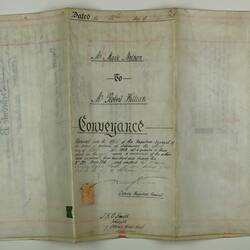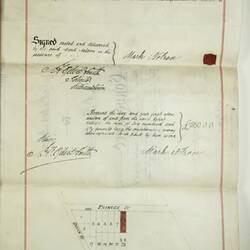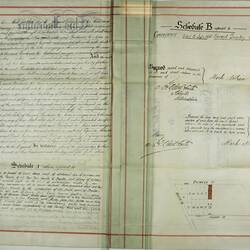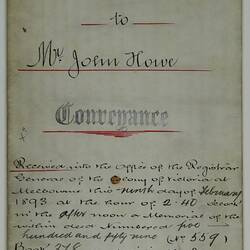Summary
Handwritten and printed conveyance dated July 20, 1886. Mark Nelson, carpenter of Williamstown, conveyed a piece of land to Robert Willian, near the intersection of Princes and Queen Streets, Williamstown for £250.
This is the earliest of four such documents representing the financial dealings of Robert Willian and others, regarding this same property over the space of eight years. Eventually being unable to make repayments, this piece of land became property of John Howe in 1893.
Robert William was born in what is now Port Melbourne in 1862. Working as a blacksmith for the Victorian Railways from 1880 until 1922, Robert spent his early life in the Williamstown area, later moving to the Ballarat area where he died in 1927.
This property (hereafter referred to as the 'Princes Street property') was probably what is now no. 17 or no. 19 Princes Street, Williamstown. The Princes Street property is located on what was called 'Smith's Paddock', which was purchased and subdivided by Edward Quigley sometime prior to July 1886. The Quigley family were responsible for naming Princes Street.
This document was drawn up at the offices of J.K.O. Smith (James Kennedy Ogilvie Smith), solicitor, Melbourne, and was received by the office of Henry Krone, Deputy Registrar General of Victoria.
Physical Description
One sheet document folded three times, with title, date and names on cover. Postage stamp on cover, textile ribbon on a reverse cover. Large amount of text printed and written in black ink with ruled red ink borders. Postage stamp and red wax seal on separate inner pages.
Significance
These documents, and the related personal stories, are significant to the state of Victoria and also to the areas of Williamstown and potentially Ballarat. They represent a single person's financial and personal struggles but also place this man within the larger context of the Depression of the 1890s and the many affected.
Aspects of the lives of the people mentioned in these documents (and their families) represent a community's involvement with events and themes in Australia's history that many feel define the nation, including immigration and a pioneering spirit of adventure, both world wars, the depression of the late 19th century. and the influenza pandemic of the early 20th century.
The documents also suggest a sense of community - both as part of Williamstown's Scottish community and the wider Williamstown community.The men involved in this property's history were workers, doctors, architects, carpenters; rich and poor, yet they were all part of one close and vibrant community, where 'class', in the traditional sense of the word, did not appear to limit people's interactions with one another.
More Information
-
Collecting Areas
Migration & Cultural Diversity, Working Life & Trades, Home & Community
-
Acquisition Information
Purchase
-
Person Named
Mr Robert M. Willian, Williamstown, Greater Melbourne, Victoria, Australia, 1886
-
Person Named
Mr Mark Nelson, Williamstown, Greater Melbourne, Victoria, Australia, 1886
-
Inscriptions
Front cover title: 'Dated the 20th day of July 1886, Mr. Mark Nelson to Mr. Robert Willian, Conveyance. Received into the office of the Registrar General of the Colony of Victoria at Melbourne the first day of October AD. 1886 at a quarter to three o'clock in the after noon a memorial of the within deed numbered three hundred and twenty two No. 322 Book 334 and verified by James Kennedy Ogilvie Smith of seven Collins Street West in the City of Melbourne, Solicitor. (signature of Henry Krone) Deputy Registrar General'.
-
Classification
-
Category
-
Discipline
-
Type of item
-
Overall Dimensions - Folded
161 mm (Width), 330 mm (Height)
-
Overall Dimensions - Unfolded
478 mm (Width), 652 mm (Height)
-
Keywords
Property Development, Legal Documents, Real Estate, Carpenters, Melbourne & Hobson's Bay Railway, Railway Workers, Railway Workshops, Railway Rollingstock, Blacksmiths











